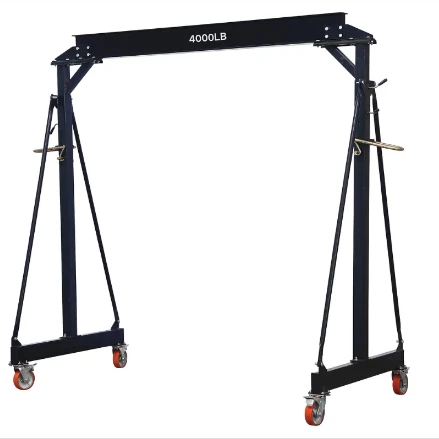Efficient Material Handling with Gantry Crane Lifting Solutions for Your Project Needs
The Evolution and Importance of Gantry Cranes in Lifting Operations
Gantry cranes have become an indispensable piece of equipment in various industrial sectors, especially in ports, construction sites, and warehouses. These robust structures, designed to lift and move heavy loads with precision, are a testament to engineering innovation. Their unique design, resembling a large bridge resting on two or more supporting beams, allows for significant lifting capabilities while providing extensive horizontal movement. This article explores the evolution of gantry cranes, their mechanisms, types, and their importance in modern lifting operations.
Historical Context
The concept of lifting heavy objects can be traced back to ancient civilizations. However, the gantry crane as we know it began to take shape in the early 20th century, driven by the need for safer and more efficient lifting methods. Initially, these cranes were constructed using wood and operated manually, but as industrial demands grew, so did the complexity and capabilities of these machines. The introduction of electric power and advanced materials revolutionized the design of gantry cranes, enabling much higher lifting capacities and greater mobility.
Mechanisms of Gantry Cranes
Gantry cranes typically consist of a hoist, a crane bridge, and a set of vertical legs. The hoist is the mechanism responsible for raising and lowering loads, while the crane bridge connects the legs and allows for lateral movement. The design of gantry cranes can vary, with some featuring a single girder and others utilizing a double girder configuration. The choice depends on the required load capacity and the specific application.
One of the key features of gantry cranes is their flexibility. They can be equipped with various attachments, such as slings, hooks, and lifting clamps, allowing them to handle different types of loads, from bulky containers to precise machinery. Moreover, advancements in technology have introduced automation into the operation of gantry cranes, significantly enhancing efficiency and safety.
Types of Gantry Cranes
Gantry cranes come in various types, each suited for specific applications.
1. Full Gantry Cranes These cranes rest entirely on their legs and can support heavy loads over long distances, making them ideal for shipping yards and large construction sites.
gantry crane lift

2. Semi-Gantry Cranes Unlike full gantry cranes, semi-gantry cranes have one leg that is fixed and another that runs on a rail. They are commonly used in workshops where space is limited.
3. Portable Gantry Cranes This lightweight option is ideal for smaller tasks. They are easy to disassemble and can be moved as needed, making them suitable for locations without a permanent installation.
Each type of gantry crane has its advantages, with considerations for weight capacity, mobility, and area of application.
Importance in Modern Operations
In today's fast-paced industrial environment, efficiency and safety are paramount. Gantry cranes significantly contribute to both aspects. Their ability to lift heavy loads reduces the risk of injury associated with manual lifting, while their precision ensures that tasks are completed accurately and quickly. This not only increases productivity but also enhances workplace safety.
Moreover, gantry cranes are cost-effective. They require less space than some other lifting equipment, making them ideal for congested work sites. Their versatility enables businesses to perform a wide range of tasks with a single piece of equipment, further enhancing return on investment.
In the context of global logistics, gantry cranes are crucial in ensuring the smooth movement of goods through ports and warehouses. Their efficiency in loading and unloading containers can dramatically reduce turnaround times, which is essential in today’s economy, where speed and efficiency dictate success.
Conclusion
The continued development and implementation of gantry cranes in lifting operations illustrate their significance in modern industry. With ongoing advancements in technology and design, these cranes will likely evolve further, embracing automation and smart technologies to meet the demands of a dynamic market. Their ability to facilitate safe, efficient, and cost-effective lifting procedures makes gantry cranes a critical component in the landscape of modern construction and logistics. As industries continue to grow, the reliance on such machinery will only increase, underscoring the importance of gantry cranes in the future of lifting operations.
-
Unlock Seamless Relocation with Our Heavy Equipment Moving ExpertiseNewsJun.06,2025
-
Unleash Unrivaled Flexibility with Our Adjustable Gantry CraneNewsJun.06,2025
-
Unleash Heavy-Duty Efficiency with Our Industrial Gantry Crane SolutionsNewsJun.06,2025
-
Revolutionize Steel Handling with Our Magnetic Lifter RangeNewsJun.06,2025
-
Master Equipment Mobility with Premium Machinery Mover SolutionsNewsJun.06,2025
-
Elevate Your Material Handling with Magnetic Lifter TechnologyNewsJun.06,2025
-
YS Permanent Lifting Magnets: The Smarter Way to Handle SteelNewsMay.22,2025
